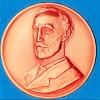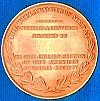
Presented by the Chicago Section
of the American Chemical Society

 | Presented by the Chicago Section of the American Chemical Society | 
|
|---|
| Gibbs Medal Awardee: |

|
|---|---|
| Professor Sylvia T. Ceyer | |
| J. C. Sheehan Professor of Chemistry Massachusetts Institute of Technology “Bulk Hydrogen: A New Kind of Surface Species with a Chemistry of its Own” |
Date: Friday, May 25, 2007 Location: Arboretum Club
401 Half Day Road, (Route 22 and Buffalo Grove Road)
Buffalo Grove, IL 60089
Warning: Check map for info on road construction near restaurant
6:00 pm Reception ( hors-d’oeuvres and both champagne punch and non-alcoholic punch )
7:00 pm Dinner
8:30 pm Presentation
Introducing Professor Ceyer: Charles (Chuck) P. Casey
Presentation of the medal: Bruce Bursten, President-Elect, American Chemical Society
Cost: $45.00 for members of ACS and their guests, $47.00 for non-members,
$22.50 for students or unemployed

| The History of the Willard Gibbs Award | 
|
|---|
The Citation:
For seminal work in molecule-surface reaction dynamics as related to
heterogeneous catalysis and semiconductor etching.
This pioneering work has uncovered new mechanisms for dissociative
chemisorption, desorption and absorption, thus revealing principles underlying chemistry at surfaces.
Experimental results include remarkable achievements using molecular
beam-surface scattering, coupled with optical and electron spectroscopies,
to measure the angular, energy and mass distributions of product molecules
from a surface chemical reaction.
Experiments that document the distinctive reactivity of H embedded in the bulk of a Ni metal catalyst are described. Specifically, a transient H atom emerging from the bulk onto the surface is observed to be the reactive species in hydrogenation of ethylene and acetylene adsorbed on Ni to form ethane and ethylene, respectively. A H atom adsorbed on the Ni surface does not hydrogenate ethylene or acetylene. However, a surface bound H atom will react with adsorbed acetylene to form ethylidyne, a precursor to coke that poisons the catalyst. The different reactivities of bulk and surface bound H arise from the very different energetics of the two kinds of H atoms. A bulk H atom reacts with an adsorbate while it is a transiently energetic species emerging from the bulk onto the surface with as much as 24 kcal/mol more energy than a reacting surface bound H atom. These results demonstrate that bulk H is not solely a source of surface bound H in catalytic hydrogenation as proposed 50 years ago, but rather, a reactant with a chemistry of its own.
Biographical Sketch of Professor Sylvia T. Ceyer:
Sylvia T. Ceyer is the Associate Chair of the Department of Chemistry and the J. C. Sheehan Professor of Chemistry at the Massachusetts Institute of Technology. She received her B.A. summa cum laude in chemistry from Hope College in 1974 and her Ph.D. from the University of California at Berkeley in 1979. After a postdoctoral appointment at the National Bureau of Standards, she accepted a position as assistant professor at MIT in 1981.
Professor Ceyer is a physical chemist with research interests in the area of molecule-surface reaction dynamics as related to heterogeneous catalysis and semiconductor etching. She has uncovered sources of the apparent lack of surface reactivity under ultrahigh vacuum conditions and then used that knowledge to effect high pressure heterogeneous catalytic reactions in an ultrahigh vacuum environment where microscopic reaction steps can be discerned. Specifically, she has uncovered new mechanisms for dissociative chemisorption and desorption such as atom abstraction, collision induced activation, absorption and desorption, provided new methods for adsorbate synthesis, demonstrated the use of electron spectroscopy as a vibrational spectroscopy sensitive to bulk species, discovered the role of bulk hydrogen in hydrogenation reactions, observed and verified the gas phase dissociation of a product of a surface reaction, identified and clarified the site conversion process, and extended the understanding of molecular precursors.
Ceyer is a fellow of the National Academy of Sciences and the former chair of its chemistry section, the secretary of the Physical and Mathematical Sciences Class of the National Academy of Sciences, a fellow of the American Academy of Arts and Sciences, a fellow of the American Association for the Advancement of Science and a fellow of the American Physical Society. She has been awarded the Hope College Distinguished Alumni Award, the Edgerton Prize, the American Association of University Women's Young Scholar Award and has been the holder of a Sloan Fellowship and a Camille and Henry Dreyfus Teacher-Scholar award. Ceyer has received the Baker Award for undergraduate teaching, the School of Science Teaching Prize and the Nobel Laureate Signature Award for Graduate Education from the American Chemical Society. In 1998, she was named a MacVicar teaching fellow at MIT.
Professor Ceyer is presently a member of the Basic Energy Sciences Advisory Committee for the Department of Energy, a member of the National Research Council's Benchmarking the Research Competitiveness of US Chemistry Committee and a member of the editorial board of Chemical Physics. Most recently, she served as an associate editor of Physical Review Letters, a member of the Program Committee of the American Association for the Advancement of Science, and a councilor of the American Physical Society. She has held numerous named lectureships including the Dreyfus Lecturer at Dartmouth University, Willard Lecturer at the University of Wisconsin, Tetelman Lecturer at Yale University, Harkins Lecturer at the University of Chicago, Welch Foundation Lecturer, Chancellor's Distinguished Lecturer at the University of California Berkeley and the Langmuir Lecturer of the American Chemical Society.
- Caesar Salad
- a choice of:
- Pecan Asiago Chicken with Garlic Mashed Potatoes, or
- Hazelnut Crusted Grouper with Wild Rice Pilaf, or
- Butternut Squash Ravioli Tossed in Garlic Cream Sauce
- Flourless Chocolate Cake
- Wine